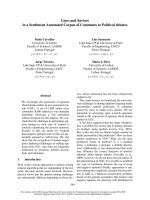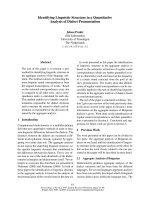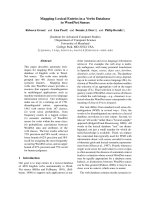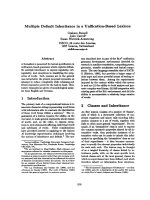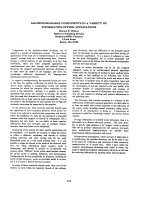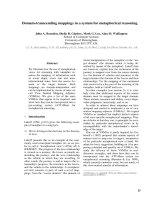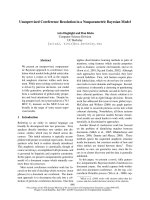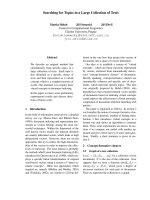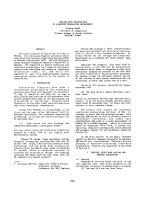Báo cáo khoa học: "Building trainable taggers in a web-based, UIMA-supported NLP workbench" potx
Bạn đang xem bản rút gọn của tài liệu. Xem và tải ngay bản đầy đủ của tài liệu tại đây (406.32 KB, 6 trang )
Proceedings of the 50th Annual Meeting of the Association for Computational Linguistics, pages 121–126,
Jeju, Republic of Korea, 8-14 July 2012.
c
2012 Association for Computational Linguistics
Building trainable taggers in a web-based, UIMA-supported NLP
workbench
Rafal Rak, BalaKrishna Kolluru and Sophia Ananiadou
National Centre for Text Mining
School of Computer Science, University of Manchester
Manchester Interdisciplinary Biocentre
131 Princess St, M1 7DN, Manchester, UK
{rafal.rak,balakrishna.kolluru,sophia.ananiadou}@manchester.ac.uk
Abstract
Argo is a web-based NLP and text mining
workbench with a convenient graphical user
interface for designing and executing process-
ing workflows of various complexity. The
workbench is intended for specialists and non-
technical audiences alike, and provides the
ever expanding library of analytics compliant
with the Unstructured Information Manage-
ment Architecture, a widely adopted interop-
erability framework. We explore the flexibil-
ity of this framework by demonstrating work-
flows involving three processing components
capable of performing self-contained machine
learning-based tagging. The three components
are responsible for the three distinct tasks of 1)
generating observations or features, 2) train-
ing a statistical model based on the generated
features, and 3) tagging unlabelled data with
the model. The learning and tagging compo-
nents are based on an implementation of con-
ditional random fields (CRF); whereas the fea-
ture generation component is an analytic ca-
pable of extending basic token information to
a comprehensive set of features. Users de-
fine the features of their choice directly from
Argo’s graphical interface, without resorting
to programming (a commonly used approach
to feature engineering). The experimental re-
sults performed on two tagging tasks, chunk-
ing and named entity recognition, showed that
a tagger with a generic set of features built
in Argo is capable of competing with task-
specific solutions.
1 Introduction
The applications of automatic recognition of cate-
gories, or tagging, in natural language processing
(NLP), range from part of speech tagging to chunk-
ing to named entity recognition and complex scien-
tific discourse analyses. Currently, there is a variety
of tools capable of performing these tasks. A com-
monly used approach involves the use of machine
learning to first build a statistical model based on a
manually or semi-automatically tagged sample data
and then to tag new data using this model. Since
the machine learning algorithms for building mod-
els are well established, the challenge shifted to fea-
ture engineering, i.e., developing task-specific fea-
tures that form the basis of these statistical models.
This task is usually accomplished programmatically
which pose an obstacle to a non-technically inclined
audience. We alleviate this problem by demonstrat-
ing Argo
1
, a web-based platform that allows the user
to build NLP and other text analysis workflows via
a graphical user interface (GUI) available in a web
browser. The system is equipped with an ever grow-
ing library of text processing components ranging
from low-level syntactic analysers to semantic an-
notators. It also allows for including user-interactive
components, such as an annotation editor, into oth-
erwise fully automatic workflows. The interoper-
ability of processing components is ensured in Argo
by adopting Unstructured Information Management
Architecture (UIMA) (Ferrucci and Lally, 2004) as
the system’s framework. In this work we explore the
capabilities of this framework to support machine
1
/>121
learning components for tagging textual content.
In the following section we present related work.
Section 3 provides background information on Argo
and its relationship to UIMA. The details of the three
machine learning components are discussed in Sec-
tion 4. Section 5 provides evaluation, whereas Sec-
tion 6 concludes the paper.
2 Related work
Language processing tools with machine learning
capabilities for tagging textual content have been
distributed by various groups in form of either stan-
dalone applications or application programming in-
terfaces (API). Packages such as Lingpipe
2
, Mal-
let
3
, Stanford NLP tools
4
and OpenNLP
5
have been
extensively used by the NLP and text mining com-
munities (Kolluru et al., 2011; Corbett and Murray-
Rust, 2006). However, such tools inherently impose
inconveniences on users, such as a lack of GUI, of-
ten arduous manual installation procedures, profi-
ciency in programming or familiarity with the de-
tails of machine learning algorithms.
These limitations are overcome by GUI-equipped,
workflow-supporting platforms that often directly
use the solutions provided by the former tools. The
notable examples of such platforms designed specif-
ically for NLP and text mining tasks are GATE
(Cunningham et al., 2002), a suite of text process-
ing and annotation tools, and U-Compare (Kano et
al., 2010), a standalone application supporting the
UIMA framework that formed the inspiration for
Argo.
Although the GUI platforms provide machine
learning solutions, these are usually limited to us-
ing pre-trained models and providing a rich set of
features for training requires resorting to program-
ming. Argo, on the other hand, allows the users to
train their own models with either a generic set of
features or customisable features without having to
write a single line of code. This capability is pro-
vided in Argo entirely through its GUI.
2
/>3
4
/>5
Figure 1: Screen capture of Argo’s web-based inter-
face.
3 Argo and UIMA
Argo’s main user interface consists of three panels
as shown in Figure 1. The left-hand panel includes
user-owned or shared storable objects; the middle
panel is a drawing space for constructing workflows
and the right-hand panel displays context-dependent
information. The storable objects are categorised
into workflows, represented as block diagrams of
interconnected processing components, documents
that represent the user’s space intended for upload-
ing resources and saving processing results, and ex-
ecutions that provide past and live workflow exe-
cution details and access points to user-interactive
components should such be present in a workflow.
Component interoperability in Argo is ensured by
UIMA which defines common structures and inter-
faces. A typical UIMA processing pipeline consists
of a collection reader, a set of analysis engines and a
consumer. The role of a collection reader is to fetch
a resource (e.g., a text document) and deposit it in
a common annotation structure, or CAS, as the sub-
ject of annotation. Analysis engines then process the
subject of annotation stored in the CAS and populate
the CAS with their respective annotations. The con-
sumer’s role is to transform some or all of the an-
notations and/or the subject of annotation from the
CAS and serialise it into some storable format.
Readers, analysers and consumers are represented
graphically in Argo as blocks with incoming only,
incoming and outgoing, and outgoing only ports, re-
spectively, visible in the middle of Figure 1.
122
(a) Training (b) Tagging
Figure 2: Two generic workflows demonstrating
the use of the Feature Generator component for (a)
training and (b) tagging.
4 Machine learning components in Argo
In order to ensure flexibility in building workflows,
we split the machine learning capability into three
distinct processing components, namely feature gen-
erator, model trainer and tagger. The trainer and
the tagger are intrinsic machine learning compo-
nents, whereas the feature generator is a convenient
and customisable processing component capable of
building a feature space for a user-defined domain.
From UIMA’s perspective, the feature generator
and the tagger are both analysis engines whose pur-
pose is to analyse the incoming CASes and en-
rich them with additional annotations; whereas the
trainer is a consumer that transforms the information
stored in CASes into a statistical model.
A typical use of the three components is shown
in Figure 2. The three components are repre-
sented as the Feature Generator, CRF++ Trainer and
CRF++ Tagger blocks. Figure 2a shows a pro-
cess of building a statistical model supported by
a document reader, common, well-established pre-
processing components (in this case, to establish
boundaries of sentences and tokens), and the previ-
ously mentioned editor for manually creating anno-
tations
6
. The manual annotations serve to generate
tags/labels which are used in the training process to-
gether with the features produced by Feature Gener-
ator. The trained model is then used in the workflow
shown in Figure 2b to tag new resources. Although
the tagging workflow automatically recognises the
labels of interest (based on the model supplied in
CRF++ Tagger), in practice, the labels need further
correction, hence the use of Annotation Editor after
the tagger.
4.1 Training and tagging
At present, our implementation of the training and
tagging components is based on the conditional ran-
dom fields (CRF) (Lafferty et al., 2001). Our choice
is dictated by the fact that CRF models are currently
one of the best models for tagging and efficient algo-
rithms to compute marginal probabilities and n-best
sequences are freely available.
We used the CRF++ implementation
7
and
wrapped it into two UIMA-compatible components,
CRF++ Trainer and CRF++ Tagger. The trainer
deals with the optimisation of feature parameters,
whereas word observations are produced by Feature
Generator, as described in the following section.
4.2 From annotations to features
The Feature Generator component is an intermedi-
ary between annotations stored in CASes and the
training component. This component is customis-
able via the component’s settings panel, parts of
which are shown in Figure 3. The panel allows the
user to 1) identify the stream of tokens
8
(Figure 3a),
2) identify the stream of token sequences (usually
6
The preprocessing and manual annotation components
could be replaced with CAS Reader, a component capable of
supplying the workflow with a previously annotated set of doc-
uments.
7
/>8
The definition of token depends on the selected UIMA an-
notation type. It may range from a simple span of text to a
complex lexical or semantic structure.
123
(a) Selecting a token annotation type
(b) Defining features
Figure 3: Feature Generator settings panel allows
the user to (a) select labels for machine learning and
(b) define features.
sentences), and 3) define features or token observa-
tions (Figure 3b).
Each feature definition consists of a name, a token
field, an optional list of token field transformations,
and an optional set of context windows. The name
is only for the user’s convenience of identifying in-
dividual feature definitions. The token field is the
primary subject of transformations (if any) and it is
one of the data fields of the selected token annota-
tion type. For instance, the token annotation type
may define data fields such as part of speech, chunk,
or lemma. By default, the system selects “covered
text”, i.e., the span of text covered by an annotation,
since this data field is available for any annotation.
If no transformation is declared, the string rep-
Figure 4: UML diagram of transformation types
resentation of the token field’s value ultimately be-
comes the value of the generated feature. If the
user declares one or more transformations then these
are applied on the token field’s value in sequence,
i.e., an outcome of the preceding transformation be-
comes an input of the following one. Figure 4 shows
the various transformations currently available in the
system.
Context windows allow for enriching the current
token’s feature set by introducing observations from
surrounding tokens as n-grams. For example, the
selected feature definition in Figure 3b, “surface has
symbols”, declares the covered text as the feature’s
basis and defines two transformations and two con-
text windows. The two transformations will first
transform the covered text to a collapsed shape (e.g.,
“NF-kappa” will become “A#a”) and then produce
“Y” or “N” depending on whether the collapsed
shape matches the simple regular expression “#”
(e.g., “A#a” will become “Y”). The two context win-
dows define six unigrams and four bigrams, which
will ultimately result in this single feature defini-
tion’s producing ten observations for training.
5 Evaluation
We show the performance of taggers trained with
two distinct sets of features, basic and extended.
The basic set of features uses token fields such as
the covered text and the part of speech without any
transformations or context n-grams. The extended
set makes the full use of Feature Generator’s settings
and enriches the basic set with various transforma-
tions and context n-grams. The transformations in-
124
Dataset Setup P R F
CoNLL Best 94.29 94.01 94.13
L2 IOBES 92.20 93.43 92.81
L2 IOB 92.14 93.27 92.70
L1 IOBES 91.95 93.17 92.55
L1 IOB 91.83 93.11 92.46
Baseline 72.58 82.14 77.07
BioNLP/ Best 76.00 69.40 72.6
NLPBA L1 IOBES 66.22 65.06 65.63
L2 IOB 66.06 64.87 65.46
L1 IOB 66.05 64.61 65.32
L2 IOBES 65.77 64.79 65.28
Baseline 52.60 43.60 47.70
Table 1: Performance of various setups (L1 vs L2,
and IOB vs IOBES) on the chunking and NER tasks.
The setups are ordered by F-score.
Dataset Setup P R F
CoNLL Basic 73.80 84.50 78.78
Extended 92.20 93.43 92.81
BioNLP/ Basic 37.06 48.13 41.88
NLPBA Extended 66.22 65.06 65.63
Table 2: Comparison of setups with basic and ex-
tended features for the chunking and NER tasks.
clude surface shape, length, prefixes, suffixes, and
the presence of various combinations of letters, dig-
its and symbols. The context n-grams include uni-
grams for all feature definitions and bigrams for se-
lected ones. Figure 3b shows a sample of the actual
extended set.
We use two datasets, one prepared for the CoNLL
2000 shared task (Tjong et al., 2000) and another
prepared for the BioNLP/NLPBA 2004 shared task
(Kim et al., 2004). They represent two different
tagging tasks, chunking and named entity recog-
nition, respectively. The CoNLL 2000 chunking
dataset involves 10 labels and comes pre-tokenised
with 211,727 tokens in the training set and 47,377
tokens in the test set. The dataset also provides part-
of-speech tags for each token. The BioNLP/NLPBA
2004 named entity recognition dataset involves five
biology-related labels and consists of 472,006 and
96,780 tokens in the training and testing sets, re-
spectively. Contrary to the former dataset, there is
no other information supporting the tokens in the
BioNLP/NLPBA dataset. To compensate for it we
automatically generated part of speech and chunk la-
bels for each token.
The chosen datasets/tasks are by no means an
exhaustive set of representative comparative-setup
datasets available. Our goal is not to claim the su-
periority of our approach over the solutions reported
in the respective shared tasks. Instead, we aim to
show that our generic setup is comparable to those
task-tuned solutions.
We further explore the options of both Feature
Generator and CRF++ Trainer by manipulating la-
belling formats (IOB vs IOBES (Kudo and Mat-
sumoto, 2001)) for the former and parameter esti-
mation algorithms (L
2
- vs L
1
-norm regularisation)
for the latter. Ultimately, there are 32 setups as the
result of the combinations of the two feature sets, the
two datasets, the two labelling formats and the two
estimation algorithms.
5.1 Results
Table 1 shows the precision, recall and f-scores of
our extended-feature setups against each other as
well as with reference to the best and baseline solu-
tions as reported in the respective shared tasks. The
gap to the best performing solution for the chunking
task is about 1.3% points in F-score, ahead of the
baseline by 15.7% points. Respectively for the NER
task, our best setup stands behind the best reported
solution by about 7% points, ahead of the baseline
by about 18% points. In both instances our solution
would be placed in the middle of the reported rank-
ings, which is a promising result, especially that our
setups are based solely on the tokens’ surface form,
part of speech, and (in the case of the NER task)
chunk. In contrast, the best solutions for the NER
task involve the use of dictionaries and advanced
analyses such as acronym resolution.
The tested combinations of the labelling formats
and parameter estimation algorithms showed to be
inconclusive, with a difference between the best and
worst setups of only 0.35% points for both tasks.
The advantage of using the extended set of fea-
tures over the basic set is clearly illustrated in Table
2. The performance of the basic set on the chunking
dataset is only at the level of the baseline, whereas
for the NER task it falls nearly 6% points behind the
125
Dataset Setup L2 L1
CoNLL Extended IOB 555 187
Basic IOB 134 70
Extended IOBES 528 209
Basic IOBES 139 72
BioNLP/ Extended IOB 865 179
NLPBA Basic IOB 226 72
Extended IOBES 860 201
Basic IOBES 217 79
Table 3: Number of iterations needed for the optimi-
sation algorithm to converge.
baseline (which comes as no surprise given that the
baseline system is a string match of entities found in
the training set).
Table 3 shows the number of iterations
9
needed
for the optimisation algorithm of the trainer to con-
verge. The advantage of the L1 regularisation is
apparent with nearly two to five times less itera-
tions needed when compared to the L2 regularisa-
tion. Given the close F-scores achieved by the two
family of setups, the L1 regularisation becomes a
clear winner in our experimentation setup.
6 Conclusions
Argo’s strength is manifested by its online avail-
ability, an intuitive graphical user interface available
from a web browser, convenience in building even
most complex text processing workflows, and the
availability of trainable machine learning compo-
nents. The Feature Generator component, customis-
able entirely through a GUI, provides the flexibility
needed to extend the basic set of features without
resorting to programming. The experiment results
showed that an extended, yet generic, set of features
can be taken to competitive levels in terms of effec-
tiveness.
7 Acknowledgements
This work was partially supported by Biotechnol-
ogy and Biological Sciences Research Council (BB-
9
We do not report detailed CPU times due to experimenting
on resource-shared machines. Such a setup makes direct side-
by-side comparisons largely skewed. As a reference we note
that the workflows completed in 15 minutes to about 11 hours
depending on a feature space size and machine load.
SRC BB/G53025X/1 From Text to Pathways) and
Korea Institute of Science and Technology Informa-
tion (KISTI Text Mining and Pathways).
References
P. Corbett and P. Murray-Rust. 2006. High-throughput
identification of chemistry in life science texts. Comp
Life, pages 107–118. LNBI 4216.
H. Cunningham, D. Maynard, K. Bontcheva, and
V. Tablan. 2002. GATE: A framework and graphi-
cal development environment for robust NLP tools and
applications. In Proc. of the 40th Anniversary Meeting
of the Association for Computational Linguistics.
D. Ferrucci and A. Lally. 2004. UIMA: An Architec-
tural Approach to Unstructured Information Process-
ing in the Corporate Research Environment. Natural
Language Engineering, 10(3-4):327–348.
Y. Kano, R. Dorado, L. McCrochon, S. Ananiadou, and
J. Tsujii. 2010. U-Compare: An integrated language
resource evaluation platform including a comprehen-
sive UIMA resource library. In Proc. of the Seventh
International Conference on Language Resources and
Evaluation (LREC 2010), pages 428–434.
J D. Kim, T. Ohta, Y. Tsuruoka, Y. Tateisi, and N. Col-
lier. 2004. Introduction to the bio-entity recogni-
tion task at jnlpba. In Proc. of the International
Joint Workshop on Natural Language Processing in
Biomedicine and its Applications, JNLPBA ’04, pages
70–75, Geneva, Switzerland. Association for Compu-
tational Linguistics.
B. Kolluru, S. Nakjang, R. P. Hirt, A. Wipat, and S. Ana-
niadou. 2011. Automatic extraction of microorgan-
isms and their habitats from free text using text min-
ing workflows. Journal of Integrative Bioinformatics,
8(2):184.
T. Kudo and Y. Matsumoto. 2001. Chunking with sup-
port vector machines. In Proc. of the second meeting
of the North American Chapter of the Association for
Computational Linguistics on Language technologies,
NAACL ’01, pages 1–8, Stroudsburg, PA, USA. Asso-
ciation for Computational Linguistics.
J. Lafferty, A. Mccallum, and F. Pereira. 2001. Condi-
tional Random Fields: Probabilistic Models for Seg-
menting and Labeling Sequence Data. In Proc. 18th
International Conf. on Machine Learning, pages 282–
289. Morgan Kaufmann, San Francisco, CA.
K. S. Tjong, F. Erik, and S. Buchholz. 2000. Introduc-
tion to the CoNLL-2000 shared task: chunking. In
Proc. of the 2nd workshop on Learning language in
logic and the 4th Conference on Computational nat-
ural language learning, pages 127–132, Morristown,
NJ, USA. Association for Computational Linguistics.
126
